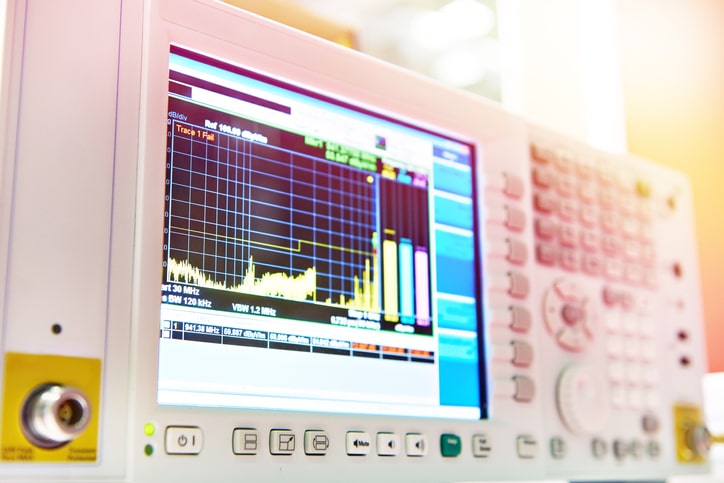
Military Susceptibility Testing
Military Susceptibility Testing is performed to determine if a product can maintain normal operation when exposed to electrical, magnetic, and radio frequency, emissions and disturbances likely to be found in its intended environment. In military applications, the density of equipment on a given platform and the levels of potential emissions and disturbances present create stringent requirements on product developers.
To properly evaluate Equipment Under Test (EUT) the product developer must identify modes of operation most vulnerable to these disturbances. Simulation and monitoring equipment must be created that can exercise EUT in these modes and provide monitoring capable of capturing any abnormalities. This equipment and its use must be documented in a test plans. These test plans must also include criteria of acceptable operation and provide safety information such as emergency shut down procedures.
MIL-STD-461 Susceptibility Testing
MIL-STD-461 is an EMI/EMC standard for developmental test and evaluation. This standard is broken out into nineteen various methods. These methods include Radiated Emissions, Conducted Emissions, Radiated Susceptibility, and Conducted Susceptibility.
Military susceptibility testing includes radiated and conducted test methods. These methods involve simulations of magnetic, radio frequency, Electrostatic Discharge (ESD), and Electromagnetic Pulse (EMP) sources of potential disturbance. Susceptibility requirements are determined by type of equipment, type of platform the equipment is to be operational on, and location of the equipment on that platform.
Susceptibility requirements for these methods generally exceed those found in commercial standards. As an example, RS103, Radiated Susceptibility, Electric Field, specifies levels as high as 200 Volts/meter across a spectrum that may extend from 2 MHz to 40 GHz.
Test Plans and EMI/EMC Testing
Given the potential of equipment malfunction that could result in hazardous conditions and the very real possibility of damage to the equipment, properly executed testing is essential to verify a product meets requirements. While MIL-STD-461 describes very concise instructions as to how a test procedure is to be conducted by test lab personnel this alone does not provide the information required about the equipment to be tested.
As previously mentioned a test plan must be created to provide this critical data to the test lab and witnesses. MIL-STD-461 sets very clear requirements for these test plans and their required information.
This information allows a lab to ascertain the specific chambers, equipment, and time that must be allotted for the procedures. It establishes test parameters and severities for the test. It provides description of the EUT, cabling, simulation, and monitoring equipment. It also provides description of modes of operation and susceptibility criteria as it applies to the acceptable operation of the equipment.
CVG Strategy EZ-Test Plan Templates for MIL-STD-461
CVG Strategy offers EZ-Test Plan Templates for EMI/EMC testing for your military susceptibility testing. These test plans compliant with MIL-STD-461 Electromagnetic Interference Test Procedures (EMITP) requirements per DI-EMCS-80201. Test plans include Addendums for documentation of equipment specific information and test lab site and equipment descriptions.
They also include instruction for test report construction that provides documentation of due diligence, information for post test analysis, and ensures repeatability of testing.
CVG Strategy Test and Evaluation Services
CVG Strategy test and evaluation experts can offer a wide array of services to assist your military susceptibility testing and other product test requirements. These services include:
Pre-Test Product Evaluation
We offer Pre-test Product Evaluation to identify and mitigate potential system design vulnerabilities before you go to test. This can streamline your test and evaluation by preventing costly redesign later in the program and lessen the requirements for retest.
Compliance by Analysis
In many cases products can be assessed to be compliant by analysis. Compliance by Analysis methods can also be used to identify potential design deficiencies early in product development, giving ample time for required modification.
Product Reliability
Product reliability testing assesses a product’s ability to perform all of its functions as designed throughout the entirety of its intended life. This is essential for equipment that must operate in conditions of high environmental and dynamic stresses. The goal of this testing is to identify potential reliability issues as early as possible so that designs can be modified prior to product release.
Product reliability testing is important in both commercial and defense product development. Each market sector has unique approaches to achieving reliability. For products designed for military applications MIL-STD-810 is a standard for developmental test and evaluation of a products reliability.
EMI/EMC Test Consulting
Military susceptibility testing presents challenging hurdles for product developers. We can help by providing state of the art analysis of product at any time in the product test and evaluation cycle and provide design modifications that will provide solutions for emissions and susceptibility issues.
We can also provide susceptibility analysis that will help safeguard your product from faulty operation caused by radio frequency interference, electrical compatibility, and radio frequency communication coexistence issues.


